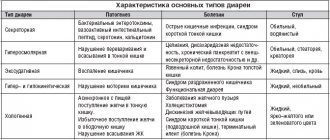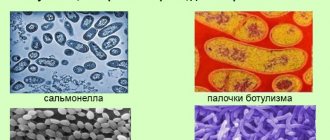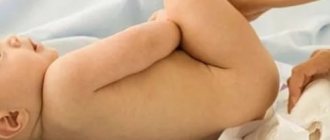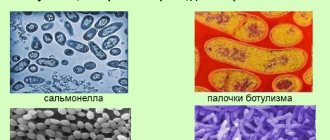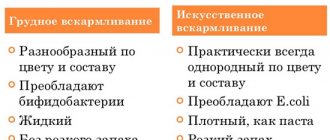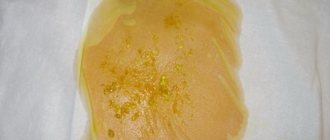Causes of vomiting and diarrhea in a child without fever
Often parents are too careless about vomiting and diarrhea in their children, if the body temperature remains normal. This is explained by the fact that adults are accustomed to the temperature against the background of any disease. However, it is worth considering that some pathological conditions can occur without this symptom. It is possible that the child has a reduced immune system or even has diseases of the immune system. As a result, the body's defenses do not respond, and the body temperature does not rise.
It is also worth remembering that in infants the symptoms of many diseases are blurred, and the deterioration of the condition occurs much faster than in older children. Therefore, in just a few hours, the baby can fall into a serious condition that is life-threatening.
Vomiting and diarrhea without body temperature in children can occur for the following reasons:
Intestinal infection
The most common intestinal infections in childhood are rotavirus infection, dysentery, salmonellosis, and escherichiasis. They can occur without fever, but it is possible to increase body temperature to subfebrile levels, and in some cases to high values.
Vomiting and diarrhea have the following characteristics:
- Vomiting does not depend on food intake and can be one-time or more frequent.
- Vomit consists of the food that the child has eaten.
- Viral infections are characterized by loose, watery stools.
- Bacterial intestinal infections are characterized by mucous stools with foam and a strong odor.
- Diarrhea with intestinal infection prevails over vomiting.
In addition, the following symptoms are characteristic of an intestinal infection:
- Severe cramping pain in the abdomen.
- Restlessness of the child, which, as diarrhea and vomiting intensify, will be replaced by drowsiness and lethargy.
- Refusal of water and food.
- As the disease progresses, increased body temperature may occur.
- Symptoms of dehydration: sunken eyes, dry eyes, lack of urination, sunken fontanel (in infancy), convulsions. These symptoms should never be ignored.
Treatment of intestinal infections in children under one year of age is carried out only in a hospital setting. If the child is older than one year, then the issue of hospitalization is decided depending on the severity of the patient’s condition.
Therapy consists of the following main activities:
- Prescription of antitoxic drugs - enterosorbents.
- Prescription of nitrofurans, furazolidone.
- Eliminating the cause of vomiting and diarrhea: antibacterial or antiviral therapy.
- Parenteral rehydration therapy.
- Elimination of symptoms of the disease: lowering body temperature, relieving pain.
The final stage of treatment is rehabilitation therapy with the administration of probiotic drugs.
Food poisoning
Food poisoning in childhood most often occurs from either dairy products or breast milk. Juices, fruit and meat purees, both home-made and factory-produced, are also dangerous.
Features of vomiting and diarrhea due to food poisoning:
- Repeated, exhausting vomiting that occurs soon after eating.
- Frequent stools with an unpleasant odor and blood.
- Diarrhea and vomiting may stop quickly, but the patient's condition will worsen.
Other symptoms of food poisoning:
- Abdominal pain is severe and occurs as spasms.
- The child's moodiness, which, as the disease progresses, gives way to lethargy and drowsiness.
- The patient refuses food and water.
All children with suspected food poisoning are subject to hospitalization (under 3 years of age). As for older children, the issue of inpatient treatment is decided depending on the severity of the patient’s condition.
Treatment of food poisoning comes down to the following points:
- Gastric lavage.
- Prescription of nitrofurans, furazolidone.
- Purpose of enterosorbents.
- Carrying out parenteral rehydration therapy.
- Prescription of anti-inflammatory drugs, antispasmodics.
The course of treatment for food poisoning always ends with restorative therapy with the administration of probiotics.
Dysbacteriosis
Vomiting with dysbacteriosis occurs infrequently, no more than 1-2 times a day. The stool is unstable, constipation is replaced by foamy diarrhea. Other symptoms of dysbiosis are: loss of appetite, rumbling and pain in the abdomen after eating, white coating on the tongue. Skin reactions are possible, but do not always occur. These include rash, itching and dry skin.
Treatment of dysbacteriosis is outpatient. To begin with, the child is offered nitrofurans for intestinal sanitation, then, against the background of nutritional correction, the intestinal microflora is restored with the help of eubiotics and probiotics.
Allergic reaction
Vomiting and diarrhea without fever may occur due to an allergy to a food product or drug. In younger children, such a reaction often occurs to the first complementary foods.
Vomiting begins soon after feeding and contains undigested food debris. In addition, the child develops itching, hives and other skin reactions. Severe allergies are accompanied by swelling of the mucous membranes of the nose and throat, and breathing problems.
Treatment depends on the severity of the allergic reaction. In mild cases, therapy is carried out at home. Antihistamines, enterosorbents and hormonal drugs are prescribed (in severe cases).
Symptoms and Causes
With nausea and loose stools, a person may experience the following symptoms:
- rough and dry skin on the arms, legs and other parts of the body;
- noticeable cracks form on the lips and in the corners of the mouth;
- severe thirst appears, which is difficult to quench even with a large amount of water drunk;
- depression, fatigue, apathy and reluctance to do anything arise, the person is very worried about this;
- problems with urination appear, the urge to go to the toilet, on the contrary, becomes frequent;
- severe pain occurs during defecation;
- the functioning of the heart muscle is disrupted, arrhythmia can be observed in the form of high blood pressure and rapid heartbeat;
- a person begins to quickly lose muscle mass, losing weight before our eyes;
- the water-salt balance is disturbed;
- sudden convulsions occur;
- Consciousness becomes cloudy, and sometimes loss of consciousness occurs.
Important! All these symptoms can occur against the background of a bacterial infection or rotavirus inflammation. The course of the disease can be quite sluggish in nature, or it can be lightning fast. It all depends on the individual characteristics of the patient and the strength of his immune system.
Food poisoning is additionally manifested by active salivation and severe weakness, which borders on fainting. With severe stress, a severe headache occurs, which does not allow a person to concentrate on any one thing. When the mucous membrane of the stomach or intestines is inflamed, as a result of chronic diseases such as gastritis, a person experiences severe heartburn.
Dysbacteriosis against the background of diarrhea and diarrhea is manifested by severe bloating and pain in this area. Low blood pressure (hypertension) manifests itself in the form of dizziness, weakness, a sharp attack of pain in the head, an attack of diarrhea and nausea.
Causes of vomiting in a child without fever
The causes of vomiting in a child without fever can be very diverse, most of them are presented in the table:
| Disease | Character of vomiting | Associated symptoms | Therapy |
| Reflux esophagitis |
|
|
|
| Pylorospasm |
|
| An operation that is performed when no effect is observed from fractional feeding and physiotherapy. |
| Pyloric stenosis |
|
| Only surgical treatment. |
| Gastritis, duodenitis. In infants, the disease most often develops from taking medications, and in older children from eating new exotic foods. |
|
| Therapy involves changing your diet. Portions should be small, drink frequently and plentifully, but in small doses. Drug therapy depends on the child's condition. |
| Intestinal diverticulum. |
| Loss of body weight. | Treatment is only surgical. |
| Intussusception. The introduction of one section of the intestine into another in children under one year of age most often occurs due to illiterate introduction of the first complementary foods, and in children at an older age due to infection with pinworms, due to intestinal polyps or tumors. | Initially, the child develops an acute attack of pain, after which vomiting of bile begins. |
| Treatment is only surgical. |
| Diseases of the digestive organs (gallbladder, liver, pancreas). |
|
| Treatment is carried out in a pediatric gastroenterology department. The child is prescribed a special diet. Depending on the type of disease, enzyme drugs, hepatoprotectors, and antispasmodics are prescribed. |
| Diseases of the central nervous system, including ischemia and hydrocephalus (for newborns), brain tumors and increased intracranial pressure (for children after one year). |
|
| Depending on the specific lesion of the central nervous system, treatment is carried out either at home or in a hospital. Drugs are prescribed to improve cerebral blood supply, or surgery is performed. |
| Ingestion of a foreign body. |
|
| Depending on the situation, either surgical treatment or observation of the child is indicated until the foreign body comes out through the intestines. |
Another pathology in which vomiting without fever is observed is appendicitis. But with appendicitis, vomiting will be only the first sign of the onset of inflammation, and after a few hours the body temperature will still increase.
Possible causes of the condition
When the human digestive system cannot fully process and absorb the nutrients entering the body with food, this indicates insufficiency of digestion. It is manifested by the following syndromes:
- starvation;
- dyspeptic syndrome;
- dehydration;
- acid-base imbalance;
- intestinal autoinfection;
- pain syndrome.
Nausea and vomiting are symptoms included in the dyspeptic syndrome (together with belching, heartburn, flatulence, etc.). Nausea is accompanied by activation of the parasympathetic nervous system. The following changes in the state of the body are observed:
- Marked weakness.
- Increased sweating.
- Paleness of the skin.
- Fall in blood pressure.
- Coldness of hands and feet.
- Hypersalivation (increased salivation).
Infections and diseases
The reasons are:
- viruses that affect the gastrointestinal tract;
- penetration and active reproduction of pathogenic microorganisms: salmonella, corynobacteria, staphylococci, shigella, vibrio cholerae;
- acute inflammatory diseases of the gastrointestinal tract (acute pancreatitis, cholecystitis);
- chronic gastrointestinal diseases (gastritis). Diarrhea may be permanent in this case;
- fermentopathy. Parietal digestion is disrupted and malabsorption syndrome develops when the absorption of substances in the intestine is impaired. The cause is hereditary disorders of the synthesis of enzymes that ensure parietal digestion. A common example is lactose (or milk sugar) intolerance. The absence of lactase, which breaks down this carbohydrate, leads to the accumulation of lactose on the surface of the mucous membrane, irritating it. There is a change in osmotic pressure in the lumen of the intestines, where water rushes, according to the osmotic gradient, causing profuse diarrhea and vomiting;
- increased intestinal motility.
External factors
- severe emotional shock;
- poor nutrition;
- pregnancy (as a manifestation of toxicosis for up to 13-16 weeks. Often in the morning);
- In children, a precipitating condition may be the start of complementary feeding after an abrupt cessation of breastfeeding. In this case, the child’s digestive system is not accustomed to the new food. Until the enzyme systems adapt to the new diet, dyspeptic syndrome is likely to develop;
- food poisoning;
- intoxication with salts of heavy metals;
- intoxication with toxic substances at work and in the home;
- taking certain medications.
Diarrhea and nausea in an adult are concomitant symptoms of poisoning, but this is not always the case. Vomiting may occur due to:
- Increased sensitivity of the vestibular apparatus - motion sickness in transport.
- Lesions of the central nervous system (trauma, tumors).
- High blood and intracranial pressure.
- Starvation.
- Overheating of the body (indoors, transport or in the sun).
- Period.
Causes of diarrhea in a child without fever
The causes of diarrhea without fever in a child may be the following:
- Intestinal infection, minor poisoning. With an intestinal infection, diarrhea is frequent, on average it happens up to 5 times per knock. If a child has poisoning, then there will be no foreign impurities in the stool, but if there is an intestinal infection, then the stool may have a non-standard color and mucous consistency. Since intestinal function is disrupted, particles of undigested food will be present in the stool. In addition to diarrhea, the child will experience abdominal pain, and the tongue will be covered with a white coating. Probably a rash. As for treatment, it depends on the severity of the intestinal infection or poisoning. In mild cases, the child remains at home.
- Allergy to a drug. Diarrhea manifests itself a couple of hours after taking the medicine. In addition, there may be skin reactions. Treatment boils down to stopping taking the drug.
- Enteritis. Inflammation of the small intestine is characterized by severe diarrhea up to 6 times per knock. The stool is greasy with food particles. The pain is localized in the navel area, appetite disappears. Treatment is carried out at home.
- Parasitic infection of the intestines. The stool is unstable, diarrhea gives way to constipation. The child loses body weight, abdominal pain similar to colic is possible, and sleep is disturbed. Increased drooling and lethargy may occur. Treatment boils down to prescribing anthelmintics.
- Dysbacteriosis. The stool is foamy, has an unpleasant odor and occurs up to several times a day. In this case, there is bloating, loss of appetite, and abdominal pain occurs a couple of hours after eating. Sometimes skin reactions appear, the tongue becomes covered with a dense white coating. Treatment at home.
It should be remembered that diarrhea without fever can also develop with other, more serious diseases. Therefore, if diarrhea does not go away after a day, then consultation with a specialist is required.
Symptoms of a viral infection
The incubation period of a viral infection lasts on average 2 days. But this period can increase to a week or decrease to 6 hours. The shorter the incubation period, the more severe the nausea, vomiting and diarrhea.
The disease always begins acutely with a rise in temperature. The person experiences chills and cannot warm up for a long time. A headache appears in the temple area, dizziness, general weakness, aching bones, and the skin becomes pale.
Then nausea sets in. The patient loses appetite, the sensitivity of receptors to external irritating factors increases, and the acuity of perception of smells and tastes increases. Some patients may experience hypersalivation - increased salivation.
At the height of the disease, vomiting occurs. This sign does not always occur, only in severe cases in weakened, elderly patients and in children (especially preschoolers). As a rule, vomiting brings temporary relief or does not bring it at all. Involuntary contractions of the diaphragm cause a person severe discomfort and pain in the stomach. In severe cases, vomiting is accompanied by a faint state.
The virus with vomiting and fever often causes diarrhea . This is a sign of an intestinal infection. Stool caused by a virus is usually periodic and does not have the same consistency as in acute infectious diseases caused by bacteria. It is more often mushy in nature than watery and does not contain pus or blood. Undigested elements of food products and single fragments of mucus are found in the stool.
If bowel movements are observed every hour and more than 8-10 times a day, you should suspect an infectious disease caused by staphylococci, salmonella, shigella, escherichia, and immediately contact an infectious diseases hospital for diagnosis.
Determining a viral intestinal infection in children is difficult, since they cannot explain their condition.
Signs of the onset of vomiting and diarrhea of viral origin in infants:
- constant crying without tears;
- refusal of baby food or breastfeeding;
- rise in body temperature to 38 °C;
- regurgitation after each feeding;
- disturbance of sleep and phase of falling asleep;
- hard stomach due to the accumulation of gases in the intestines, rumbling;
- diarrhea is frequent, stool is liquid, foamy, yellow in color with a pungent odor.
The baby's condition is serious. Dehydration of the body quickly develops, which significantly worsens the course of the disease.
Causes of vomiting and diarrhea without fever that are safe for a child’s life
Vomiting and diarrhea without an increase in body temperature do not always indicate serious problems with the child’s health. Often these two symptoms simply accompany the natural physiological states of children.
Only vomiting (without fever and diarrhea) can occur in a child for the following reasons:
Physiological regurgitation
An infant may vomit milk or formula. However, his health does not deteriorate, his body weight remains within normal limits. Children burp up to 20 ml at a time. The discarded contents consist of curdled milk without foreign impurities.
The causes of physiological regurgitation may be the following:
- Large amounts of food.
- Incorrect posture of the baby during feeding.
- Imperfection of the digestive tract of infants.
- Incorrect nipple latching.
To reduce the frequency of regurgitation, the baby should be held with his head slightly elevated during feeding. After eating, you need to put the baby in an upright position for 15 minutes. This will allow excess air to escape. It is equally important to monitor the amount of food that an infant consumes.
Teething
Vomiting when the first teeth appear is not associated with food intake, its volumes are insignificant, and no cyclical behavior is observed. It happens due to the baby crying during feeding, which is explained by sore gums. At the same time, when screaming, children swallow too much excess air. Also, you should not force your child to eat while he is teething.
You can help your child in the following ways:
- Massage the gums with your finger or using a teether.
- Apply a gel with an anesthetic component to the gums.
- Avoid force-feeding if the child does not want to eat. Incorrect introduction of complementary foods
Vomiting due to improper introduction of complementary foods occurs once and does not harm the child’s health. It is explained by the fact that the body either does not accept the new product, or that the enzymatic system is not yet able to cope with the introduced components.
If vomiting occurs, the new product should be excluded from the child’s menu for several weeks or more. After this time, you can offer it again, but in small quantities.
Psychogenic vomiting
Neurotic vomiting is typical for children over the age of three. It occurs as a reaction to a certain stress factor.
Common causes of psychogenic vomiting are:
- Parents insisting that their child eat
- The child has experienced strong positive or negative emotions, including resentment or anxiety.
- The child is very worried before any important event for him.
If a child experiences episodes of psychogenic vomiting, it is necessary to protect him as much as possible from a stressful situation and consult with a child psychotherapist.
First aid for a child with diarrhea without fever and vomiting
If diarrhea does not disturb the general condition of the child and is not accompanied by abdominal pain, nausea, vomiting, fever and other signs of illness, parents can independently take the following measures:
- A gentle diet . A child's diet with diarrhea should exclude the consumption of dairy and fermented milk products, fruit juices, fatty meats and fish, fried, smoked and spicy foods, vegetables and fruits rich in fiber (cabbage, legumes, radishes, etc.), broths, baked goods and sweets . All dishes must consist of boiled and/or steamed foods. You can offer your child porridge cooked in water, lean meats or poultry, baked apples, bananas, crackers, mashed potatoes in water.
- Drinking regime . In young children, diarrhea can lead to dehydration especially quickly. In this regard, parents of infants (as well as children of any age) should monitor the replenishment of fluid in the child’s body during diarrhea. In case of diarrhea, children can drink boiled water, unsweetened compote, a decoction of dried fruits and raisins. Pharmaceutical preparations containing the necessary salts are also used: “Regidron”, “Glucosan”, etc.
- Restoration of the microflora of the digestive tract . There are many types of medicines for the treatment of dysbiosis, which include bifidobacteria, which are necessary for the normal functioning of the child’s gastrointestinal tract. These are drugs such as Linex, Bifiform, Biogaya, etc.
- Taking enterosorbents . Drugs in this group help remove toxins, pathogenic microorganisms and their waste products from the child’s body. These are medications such as: “Enterosgel”, activated carbon, “Lactofiltrum”, “Smecta”, “Enterodez”, etc.
If diarrhea does not stop within two days, or if other symptoms of the disease occur, parents should immediately seek medical help. Only a doctor can make an accurate diagnosis and prescribe the correct treatment for a child.
What can you give your child for vomiting and diarrhea?
Since vomiting is not an independent disease, but a symptom of poisoning of the body, or a sign of some kind of infection, antiemetic drugs should not be offered to a child. Stopping vomiting with the help of antiemetics will only worsen the patient’s condition, since all harmful substances will remain inside and be absorbed into the blood. If the cause of vomiting is not food poisoning, you cannot self-medicate. It is necessary to seek help from specialists as soon as possible in order to prevent serious problems with the child’s health.
To stop diarrhea, you should also not give your child antibacterial drugs (Enterofuril, Levomycetin, Loperamide (Imodium), Furazolidone), since most often they will not have a therapeutic effect. Statistics indicate that in the vast majority of cases, diarrhea in childhood is caused by a viral intestinal infection, food poisoning, or overeating. In each of the three cases, antibiotics will not help. In addition, stopping diarrhea, like vomiting, will cause harmful substances to stay longer in the body and continue to poison it from the inside.
Most likely, parents who independently gave their child an antibiotic for vomiting and diarrhea will claim that both of these symptoms stopped 1-3 days after starting to take the medicine. However, it is known that a viral intestinal infection goes away on its own during this period, which means taking antibiotics was unjustified and unnecessary. In case of poisoning, diarrhea stops after all harmful substances are eliminated from the body. Therefore, antibacterial therapy does not have a positive effect on the course of the disease.
However, you can help your child’s body cope with infection and poisoning by offering him probiotics and enterosorbents. The action of the first drugs is aimed at destroying viruses, and the second at binding harmful substances and preventing them from entering the blood. Therefore, in case of food poisoning, the child is given enterosorbents, and in case of intestinal infection, probiotics.
If the child is very small and is breastfed, then he is allowed to be given only Smecta (enterosorbent), or the probiotics Linex and Bifidumbacterin. When the child is over two years old, he is prescribed the following sorbents: White Coal, Enterosgel, Filtrum and Smecta. After two years, diarrhea can be eliminated with a drug called Enterol.
Also, for diarrhea, regardless of the child’s age, he can be given Zincit (10 to 20 mg per 24 hours), or another zinc preparation. As for Zincite, the course of treatment is from 10 to 14 days.
So, the first priority facing parents is to restore electrolytes and lost fluids. The child is not given antiemetic drugs, but for diarrhea they are offered either enterosorbents or probiotics, depending on the cause of the disease.
Lost fluid is restored using special saline solutions, which can be purchased at a pharmacy. The most famous of them are Regidron and Regidron Bio, but you can also buy the drugs Disol and Trisol. If you can’t visit a pharmacy, you can make your own saline solution. To prepare it you will need a liter of boiled water, a teaspoon of salt, five teaspoons of sugar. It is necessary to ensure that the sick child constantly drinks this liquid, but in small sips.
As soon as the attack of diarrhea or vomiting ends, you need to give the child water or saline solution. You should not wait for the medicine to work. If vomiting recurs, then water is offered again. Infants are placed to the breast as often as possible and given additional water during feeding. Older children are fed boiled vegetables, rice, lean meat, and are offered kefir or other fermented milk product. Food is given in small portions. Until the end of the illness, children can be on the BRNS diet (lamb, rice, apples and crackers). Liquid must be supplied to the body during breaks in food (at least 60 ml for infants, at least 100 ml for children after 2 years). If a child drinks the required volumes of liquid, but asks for more, then you should not refuse him this.
During vomiting and diarrhea, carbonated drinks and juices, chicken broth and milk, as well as rice water are strictly prohibited. All these fluids will aggravate the course of the disease by dehydrating the body.
If vomiting and diarrhea are persistent and do not stop for 4 hours, then you should call a doctor so that he can adequately assess the child’s condition. Hospitalization may be required, as persistent vomiting often indicates meningitis, a concussion, or other serious pathology.
Situations in which calling a local doctor or ambulance is mandatory:
- Three or more episodes of vomiting, one after the other, in less than three hours.
- The child’s refusal not only to eat, but also to drink liquids.
- Everything that the child eats and drinks comes out in vomit.
- Lack of tears while crying.
- The child is drowsy and lethargic, he has dry lips and eyes.
- The vomit contains blood.
- Complaints of headaches, as well as neck muscle tension and loss of consciousness.
- Suspicion of poisoning.
Other episodes of vomiting and diarrhea, as a rule, can be successfully stopped by taking the above medications and adequately replenishing lost fluid and electrolytes.
On the topic: what to do if a child has severe vomiting?
Treatment
Treatment of vomiting and diarrhea without fever is necessary if the condition persists for a long time or is accompanied by other symptoms. Then make an appointment with your doctor.
Medicines
There is vomiting and diarrhea accompanied by weakness in the body - take sorbents, regular activated carbon, or Smecta, Enterosgel, Sorbex and analogues.
If vomiting and diarrhea persist for a long time, drink more fluids to avoid dehydration. You can take Regidron solution.
If you have eaten too much, take a Mezim or Festal tablet.
Diet
The doctor prescribes a diet for diarrhea and vomiting without fever. But if the general rules are:
- Eat small portions, but more often, do not overeat
- Low-fat kefir and more water
- Steamed cereals and vegetables
- Lean meat and fish, steamed, boiled or oven
What to do if there is a complication
First aid for diarrhea and vomiting, if the stomach is hard and hurts:
Lay the person down on the surface. Free the person from clothing in the abdominal area. Have the person twist around a little to find a comfortable position where pain is minimal.
Drink some water.
Do not give medications to relieve pain, because this will distort the symptoms for the doctor.
Do not apply heat to the area of pain, as this may cause more inflammation. Do not apply anything cold as this may cause spasms.
Do not treat the condition yourself. After diagnosis, the doctor will prescribe treatment.
A viral infection manifests itself not only as a cold when the respiratory tract is affected. Pathogenic microorganisms cause inflammatory processes in the digestive organs . Invading the intestinal mucosa, they multiply intensively, which leads to intoxication of the body. Virus, vomiting, diarrhea and fever inevitably happen to every person. In adults, the manifestations of the disease go away on their own after a few days without specific treatment. In children, such symptoms are more severe and require symptomatic therapy.
What is considered diarrhea?
Diarrhea in a child (in common parlance - diarrhea) is characterized by frequent, loose stools occurring more than twice a day. In other words, if a child passes loose stools once a day, this is not diarrhea. But if attacks of defecation become more frequent or their character changes, it’s time to sound the alarm.
Diarrhea itself is not an independent disease, but a clear clinical manifestation of intestinal dysfunction. Diarrhea can have various causes and is not always associated with poisoning from poor-quality food. Stool liquefaction occurs against the background of an increase in fluid in the body: up to 90% water content in liquefied stool.
Diarrhea, depending on the reasons, can last for quite a long time, attacks can either intensify or subside, the acute period lasts up to 2 weeks.
WHO experts divide diarrhea into several types depending on the causes:
- infectious (salmonellosis, rotavirus, dysentery);
- toxic;
- nutritional;
- medication;
- dyspeptic;
- neurogenic.
Still, the most common cause of diarrhea in children is infectious diseases and poisoning, accompanied by vomiting and fever.


